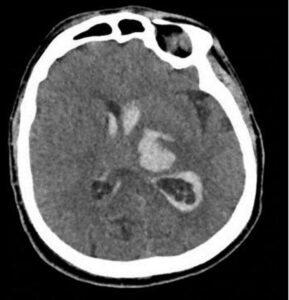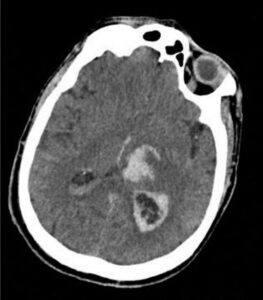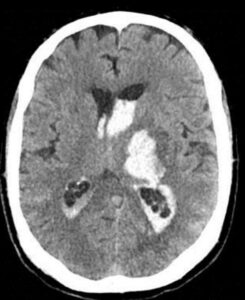Salvatore Marrone1*, Federica Paolini1,2, Evier Andrea Giovannini1,2, Giovanni Cinquemani1, Rita Lipani1, Luca Ruggeri1, Jaime Mandelli1, Domenico Iatì3, Antonio Alessandro Biancardino2, Domenico Gerardo Iacopino2, Luigi Basile1
1Unit of Neurosurgery, Sant’Elia Hospital, Caltanissetta, Italy
2Unit of Neurosurgery, Department of Biomedicine, Neuroscience and Advanced Diagnostics, Post Graduate Residency Program in Neurosurgery, University of Palermo, Italy
3Unit of Interventional Neuroradiology, Diagnostic Imaging, Sant’Elia Hospital, Caltanissetta, Italy
*Correspondence author: Salvatore Marrone, MD, Unit of Neurosurgery, Sant’Elia Hospital, Caltanissetta, Italy; Email: [email protected]
Published Date: 04-06-2024
Copyright© 2024 by Marrone S, et al. All rights reserved. This is an open access article distributed under the terms of the Creative Commons Attribution License, which permits unrestricted use, distribution, and reproduction in any medium, provided the original author and source are credited.
Abstract
Reactivity of the choroid plexuses in neurovascular or traumatic pathologies has long been studied. Presence of intraventricular hematoma during basal ganglia hemorrhagy is a negative prognostic factor since correlates with increased risk of hydrocephalus. The dynamic evolution of an intraventricular hematoma may be influenced by the secretory activity of the plexuses but also the very presence of intraventricular tumors could modify the morphology of the hematoma. Pathologies such as Xanthogranulomas of the choroid plexuses are benign malformations, as they are asymptomatic they are generally found as incidentalomas. Having a density similar to that of the choroid plexuses they may not be easily observed. Brain CT study in 73-year-old male patient showed left basal ganglia hemorrhage with hemoventricle occupying a large part of the trigone with a honeycomb-like radiological pattern. This pattern was characterized by the presence of hemorrhagic hyperdensity with irregular hypodense lobulated alveoli inside separeted by isodense septa. The above morphological pattern persisted and was unveiled even controlaterally in subsequent CT follow-ups.
Keywords: Intraventricular Haemorrhage (IVH); Honeycomb-Like CT Pattern; Choroid Plexus Xantogranuloma (CPX); Cerebrospinal Fluid (CSF) Secretion; Hematoma Shaping
Abbreviations
IVH: Intraventricular Haemorrhage; CSF: Cerebrospinal Fluid; CPX: Choroid Plexus Xantogranuloma
Introduction
Intraventricular Haemorrhage (IVH) may be secondary to the extension of a Intraparenchymal Haemorrhage (ICH) or directly caused by bleeding of the Choroid Plexuses (CPs) for neoplastic causes [1-6]. Hemoventricle is a negative prognostic factor as it increases the ICH score [7-10]. The intraventricular space may be the site of primary or secondary lesions that spread by CSF or directly by diffusion (exfoliation) from the choroid plexuses [11-16]. The reaction of the CPs to vascular or neoplastic lesions has long been studied and its re-activity could interfere with the shaping of an intraventricular haematoma confering particular morphology. We will see that IVH morphology in the region of ventricle trigone may mold over the CPX getting a honeycomb appearance. Generally, Xantogranuloma of the Central Nervous System are granulomatous tumors characterized by lamellated cholesterol clefts with hemosiderin deposits, reactive fibrosis and inflammatory infiltrates (predominantly lymphocytes) [4]. Xantogranuloma of Choroid Plexus (CPX) are benign idiopathic and asymptomatic lesions, usually unilateral but may be bilateral with cystic appearance [15]. When associated with inflammation they can bleed and become symptomatic [17-20]. CT pattern described in this report is not very common and often could get unnoticed, but when found it should raise suspicion of the CPXs.
Case Description
73-year-old patient with history of severe hypertension presented state of consciousness with GCS 9/15 preceded by incoercible headache. No known pathology in neurological history to date. On neurological examination he presented with right facio-brachio-crural hemiplegia, myopic and isochoric pupils. Brain CT study showed left nucleo-capsular haemorrhage and intraventricular haemorrhage with irregular honeycomb-shape located in lateral ventricle trigone and 1.1 cm shift. On reaching a GCS of 7/15 he was intubated and maintained in deep-sedation for neuroprotection. The diagnosis of suspected CPXs no was obvious already at the first CT scan. Indeed, it was interesting to note that next CT studies performed after 3-12-24 hours confirmed and improved visualization of this hematoma pattern bilaterally. The patient was extubated with a GCS of 9/15 and had a gradual reduction of the hemorrhagic component accompanied by a gradual recovery of symptoms until his discharge (Fig. 1-4).

Figure 1: Brain CT at time 0 showing onset of honeycomb pattern in left trigone region of lateral ventricle with tight hyperdense wall (acute blood density) and thin septa inside, in presence of left deep ganglia hemorrhage and hemoventricle.

Figure 2: In 3h CT control is visualizable a stationary honeycomb pattern in left trigone, while in posterior part of the contralateral trigone an iso-hyperdense layer begins to appear.

Figure 3: CT scan performed 12 h later shows an increase in cerebral hemorrhage: early hyperdense wall in right trigone region, while the honeycoomb pattern remains stationary on the left side.

Figure 4: In the 24-hour control, the pattern in the left trigon is clearly more evident, whose walls are well hyperdense and the penetrating sepiments (septa) are iso-hyperdense but still evident radiologically.
Discussion
An intracranial hematoma can have variable shapes since it is subjected to severe forces by increasing endocranial hypertension. Some CT markers, each with a different hypodensity/hyperdensity ratio (difference varying from 15 to 30 HU), have been analyzed and considered prognostic markers since they correlate with increased expansion risk [17]. The hemoventricle CT-pattern here described is a honeycomb-like pattern characterized by hypodensity with irregular and lobular margins in choroid plexuses region. This pattern was not immediately evident bilaterally. In fact, as CT scans continued and the intraventricle blood spread increased, this honeycomb-like pattern became increasingly evident. Because CPXs generally have similar density to CPs, they on CT may go undetected [15]. Therefore, it is likely that peripheral hyperdense blood served to increase the “density contrast” between these areas and facilitated the visualization of CPXs with this atypical pattern. In some instances, Xantogranuloma may have hyperdense or hypodense radiological aspect depending on the calcification degree, the presence of bleeding and blood clotting, the thickening of the capsule and the pericapsular reaction of contiguous tissues [4,20]. The morphology of the IVH is certainly molded on the trigone CPX and acquired a honeycomb aspect. Attention to radiological features such as irregularly pyramidal shape, diffusely trabeculated inside and thick peripheral hyperdensity may help to discern intraventricular hematoma from a xanthogranuloma, where intra-plexus homogenous calcifications are usually found [5]. Since most CPXs are asymptomatic many are discovered as incidentalomas. When found, it is rare that they are bilateral. If the patient had two bilateral CPXs probably already at the first CT (time 0) the density in the contralateral trigone region would have been suggestive. Even though the patient had no neurological pathology in history, CT morphology allowed the diagnosis of CPX to be made. Although the presence of CPXs contributed primarily to organization of this pattern, CSF secretion in reaction to blood stimuli may have helped shape the morphology of intraventricle hematoma. In chronic diseases some changes in CPs morphology and function have been reported [7]. Coagulation of the blood within liquid cavities, such as ventricles, may have different evolution than intraparenchimal one. Hyperdensity with irregular margins would explain the attempted formation and gradual coagulation of the intra-ventricle blood mass, where the alternation of convective-unidirectional and pulsatile-bidirectional flows can change the shape of haematoma since it has not yet fully clotted [19]. As described in a study by Xiang, choroid plexus plays an important function in responding to brain damage, attempting to reduce its effects both “adjacent to” and “distant from” the lesion with mechanisms only partially elucidated [21]. During intracranial haemorrhage, could occur compensation mechanisms such as altering the morphology of CPs epithelial-ependimal cells (shrinking, apoptosis) and their function, replying with hypo- or hyper-secretion [2,12]. Alteration of Cerebrospinal Fluid (CSF) volume and speed secretion could still influence the ventricular haematoma organization. In keeping with Monroe-Kelley law and due to increased sympathetic tone CSF secretion should be reduced as a compensation mechanism [11,18]. However, many components released by the haemorrhage and inflammation (haemoglobin degradation proteins, cytokines, ROS, iron cations) can lead to hypersecretion [8,9,13]. Therefore, spreading of blood from the ventricle to the subarachnoid space (SAH) may be associated with alterations in CSF dynamics as already described by Dòczi in 1983 [3]. Both the presence of hypertrophic plexuses, typical of the elderly that jut into hematoma and the rapid liquor secretion could interfere with blood pooling in presence of acute stormy flow [1,14]. These alterations of CSF secretion could act upon clot stability modifying hematoma morphology and giving it a heterogeneous radiological appearance [2]. It is unclear whether this honeycomb-like pattern is to be attributed to physiopathology of acute cerebral hemorrhage. To the best of our knowledge this has never been studied but it may be worthy of further targeted studies and investigations to better understand its meaning.
Conclusion
CPXs are generally asymptomatic and discovered incidentally. The presence of these malformations can affect the organization of IVH and alterations in CSF secretion could affect the IVH morphology conferring a characteristic radiological mold pattern. CPXs, having a density similar to CPs one, may not be easily spotted. Thus, the presence of hyperdense acute hematoma may have facilitated, due to black and white contrasts, the visualization of this pattern.
Conflict of Interests
Authors declare that there is no conflict of interest for this paper.
References
- Alisch JSR, Kiely M, Triebswetter C, Alsameen MH, Gong Z, Khattar N, et al. Characterization of age-related differences in the human choroid plexus volume, microstructural integrity and blood perfusion using multiparameter magnetic resonance imaging. Front Aging Neurosci. 2021;13.
- Ben-Shoshan SD, Lolansen SD, Mathiesen TI, MacAulay N. CSF hypersecretion versus impaired CSF absorption in posthemorrhagic hydrocephalus: a systematic review. Acta Neurochir (Wien). 2023;165:3271-87.
- Dóczi T, Nemessányi Z, Szegváry Z, Huszka E. Disturbances of cerebrospinal fluid circulation during the acute stage of subarachnoid hemorrhage. Neurosurg. 1983;12:435-8.
- Emon ST, Ozturk E, Meric K, Aker F, Orakdogen M. Symptomatic bilateral xanthogranuloma of the choroid plexus. J Neurosci Rural Pract. 2017;08:S123-6.
- Handagoon P, Pitakdamrongwong N, Shuangshoti S. Xanthogranulomas of choroid plexus. Neuroradiol. 1987;29:172-3.
- Hinson HE, Hanley DF, Ziai WC. Management of intraventricular hemorrhage. Curr Neurol Neurosci Rep. 2010;10:73-82.
- Hubert V, Chauveau F, Dumot C, Ong E, Berner LP, Canet-Soulas E, et al. Clinical imaging of choroid plexus in health and in brain disorders: a mini-review. Front Mol Neurosci. 2019;12.
- Johnsen LØ, Friis KA, Damkier HH. In-vitro investigation of the effect of proinflammatory cytokines on mouse choroid plexus membrane transporters Ncbe and NKCC1. Fluids Barriers CNS. 2023;20:71.
- Karimy JK, Zhang J, Kurland DB, Theriault BC, Duran D, Stokum JA, et al. Inflammation-dependent cerebrospinal fluid hypersecretion by the choroid plexus epithelium in posthemorrhagic hydrocephalus. Nat Med. 2017;23:997-1003.
- Kittiwattanagul W, Namwaing P, Khamsai S, Sawanyawisuth K. Clinical characteristics and outcomes of patients with intracerebral hemorrhage: nonsurgical versus surgical treatment. J Emerg Trauma Shock. 2023;16:145-9.
- Lindvall M, Owman C. Autonomic nerves in the mammalian choroid plexus and their influence on the formation of cerebrospinal fluid. J Cerebral Blood Flow and Metabolism. 1981;1:245-66.
- Liu R, Zhang Z, Chen Y, Liao J, Wang Y, Liu J, et al. Choroid plexus epithelium and its role in neurological diseases. Front Mol Neurosci. 2022;15.
- Lolansen SD, Rostgaard N, Barbuskaite D, Capion T, Olsen MH, Norager NH, et al. Posthemorrhagic hydrocephalus associates with elevated inflammation and CSF hypersecretion via activation of choroidal transporters. Fluids Barriers CNS. 2022;19:62.
- Park J, Hwang SK. Transcranial doppler study in acute spontaneous intracerebral hemorrhage: the role of pulsatility index. J Cerebrovasc Endovasc Neurosurg. 2021;23:334-42.
- Pear B. Xanthogranuloma of the choroid plexus. Am J Roentgenol. 1984;143:401-2.
- Scalia G, Silven MP, Costanzo R, Porzio M, Maugeri R, Iacopino DG, et al. Intraventricular cerebral metastases: a comprehensive systematic review. Anticancer Res. 2024;44:453-62.
- Shakya MR, Fu F, Zhang M, Shan Y, Yu F, Sun S, et al. Comparison of black hole sign, satellite sign and iodine sign to predict hematoma expansion in patients with spontaneous intracerebral hemorrhage. Biomed Res Int. 2021;2021:1-8.
- Walsh J. Measuring intracranial pressure. Crit Care Nurse. 2024;44:73-5.
- Wichmann TO, Damkier HH, Pedersen M. A brief overview of the cerebrospinal fluid system and its implications for brain and spinal cord diseases. Front Hum Neurosci. 2022;15.
- Wolf A, Cowen D, Graham S. Xanthomas of the choroid plexus in man. J Neuropathol Exp Neurol. 1950;9:286-97.
- Xiang J, Routhe LJ, Wilkinson DA, Hua Y, Moos T, Xi G, et al. The choroid plexus as a site of damage in hemorrhagic and ischemic stroke and its role in responding to injury. Fluids Barriers CNS. 2017;14:8.
Article Type
Case Report
Publication History
Received Date: 05-05-2024
Accepted Date: 27-05-2024
Published Date: 04-06-2024
Copyright© 2024 by Marrone S, et al. All rights reserved. This is an open access article distributed under the terms of the Creative Commons Attribution License, which permits unrestricted use, distribution, and reproduction in any medium, provided the original author and source are credited.
Citation: Marrone S, et al. Odd Hemoventricle Pattern Masking Bilateral Trigone Xantogranulomas. J Neuro Onco Res. 2024;4(2):1-5.

Figure 1: Brain CT at time 0 showing onset of honeycomb pattern in left trigone region of lateral ventricle with tight hyperdense wall (acute blood density) and thin septa inside, in presence of left deep ganglia hemorrhage and hemoventricle.

Figure 2: In 3h CT control is visualizable a stationary honeycomb pattern in left trigone, while in posterior part of the contralateral trigone an iso-hyperdense layer begins to appear.

Figure 3: CT scan performed 12 h later shows an increase in cerebral hemorrhage: early hyperdense wall in right trigone region, while the honeycoomb pattern remains stationary on the left side.

Figure 4: In the 24-hour control, the pattern in the left trigon is clearly more evident, whose walls are well hyperdense and the penetrating sepiments (septa) are iso-hyperdense but still evident radiologically.


